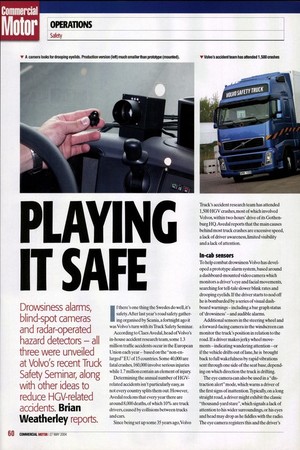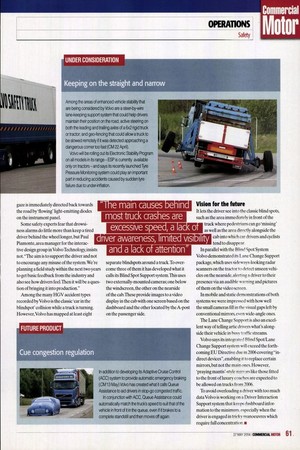PLAYING IT SAFE
Page 62

Page 63

If you've noticed an error in this article please click here to report it so we can fix it.
Drowsiness alarms, blind-spot cameras and radar-operated hazard detectors — all three were unveiled at Volvo's recent Truck Safety Seminar, along with other ideas to reduce HGV-related accidents. Brian
Weatherley reports.
If there's one thing the Swedes do well, it's safety After last year's road safety gathering organised by Scania, a fortnight ago it was Volvo's turn with its Truck Safety Seminar. According to Claes Avedal, head of Volvo's in-house accident research team, some 1.3 million traffic accidents occur in the European Union each year — based on the "non-enlarged" EU of 15 countries. Some 40,000 are fatal crashes,160,000 involve serious injuries while 1.7 million contain an element of injury
Determining the annual number of HGVrelated accidents isn't particularly easy, as not every country splits them out. However, Avedal reckons that every year there are around 8,000 deaths, of which 10% are truck drivers, caused by collisions between trucks and cars. Since being set up some 35 years ago, Volvo
Truck's accident research team has attended 1,500 HGV crashes, most of which involved Volvos, within two-hours' drive of its Gothenburg HQ.Avedal reports that the main causes behind most truck crashes are excessive speed, a lack of driver awareness, limited visibility and a lack of attention. In-cab sensors
To help combat drowsiness Volvo has developed a prototype alarm system, based around a dashboard-mounted video camera which monitors a driver's eye and facial movements, searching for tell-tale slower blink rates and drooping eyelids. If the driver starts to nod off he is bombarded by a series of visual dashboard warnings— including a bar graph status of 'drowsiness' — and audible alarms.
Additional sensors in the steering wheel and a forward-facing camera in the windscreen can monitor the truck's position in relation to the road. If a driver makes jerky wheel movements — indicating wandering attention— or if the vehicle drifts out of lane, he is brought back to full wakefulness by rapid vibrations sent through one side of the seat base, depending on which direction the truck is drifting. The eye camera can also be used in a "distraction alert" mode, which warns a driver of the first signs of inattention.Typically, on a long straight road, a driver might exhibit the classic "thousand-yard stare", which signals a lack of attention to his wider surroundings, or his eyes and head may drop as he fiddles with the radio. The eye camera registers this and the driver's
gaze is immediately directed back towards the road by 'flowing' light-emitting diodes on the instrument panel. Some safety experts fear that drowsiness alarms do little more than keep a tired driver behind the wheel longer, but Paul Piamonte, area manager for the interac
tive design group in Volvo Technology, insists not. "The aim is to support the driver and not to encourage any misuse of the system. We're planning a field study within the next two years to get basic feedback from the industry and also see how drivers feel.Then it will be a question of bringing it into production." Among the many HGV accident types recorded by Volvo is the classic 'car in the blindspot' collision while a truck is turning. However,Volvo has mapped at least eight
separate blindspots around a truck.To overcome three of them it has developed what it calls its Blind Spot Support system.This uses two externally-mounted cameras; one below the windscreen, the other on the nearside of the cab.These provide images to a video display in the cab with one screen based on the dashboard and the other located by the A-post on the passenger side. Vision for the future It lets the driver see into the classic blind spots, such as the area immediately in front of the truck where pedestrians can go 'missing' as well as the area directly alongside the
cab into which car drivers and cyclists tend to disappear.
In parallel with the Blind Spot System Volvo demonstrated its Lane Change Support package, which uses sideways-looking radar scanners on the tractor to detect unseen vehicles on the nearside, alerting a driver to their presence via an audible warning and pictures of them on the video screen.
In mobile and static demonstrations of both systems we were impressed with how well the small cameras fill in the visual gaps left by conventional mirrors, even wide-angle ones.
The Lane Change Support is also an excellent way of telling artic drivers what's alongside their vehicle in busy traffic streams.
Volvo says its integrated Blind Spot/Lane Change Support system will exceed the forthcoming EU Directive due in 2006 covering "indirect devices", enabling it to replace certain mirrors, but not the main ones. However, 'praying mantis'-style mirrors like those fitted to the front of luxury coaches are expected to be allowed on trucks from 2006. To avoid overloading a driver with too much data Volvo is working on a Driver Interaction . Support system that keeps dashboard information to the minimum, especially when the driver is engaged in tricky manoeuvres which require full concentration.•
Keeping on the straight and narrow
Among the areas of enhanced vehicle stability that are being considered by Volvo are a steer-by-wire lane-keeping support system that could help drivers maintain their position on the road; active steering on both the leading and trailing axles of a 6x2 rigid truck or tractor; and geofencing that could allow a truck to be slowed remotely if it was detected approaching a dangerous corner too fast (CM 22 April).
Volvo will be rolling out its Electronic Stability Program on all models in its range ESP is currently available only on tractors and says its recently launched Tyre Pressure Monitoring system could play an important part in reducing accidents caused by sudden tyre failure due to under-inflation.
Cue congestion regulation
In addition to developing its Adaptive Cruise Control (ACC) system to provide automatic emergency braking (CM13 May) Volvo has created what it calls Queue Assistance to aid drivers in stop-go congested traffic.
In conjunction with ACC, Queue Assistance could automatically match the truck's speed to suit that of the vehicle in front of it in the queue, even if it brakes to a complete standstill and then moves off again.






























































































































































































